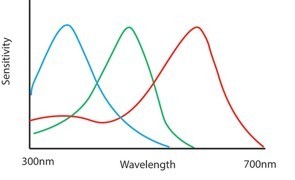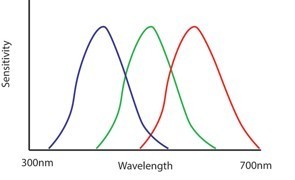Our eyes had to make sacrifices to help us survive.

Most mammals rely more on smell than sight. Look at the dog's eyes - they are located on the sides of the muzzle, not like in people with whom they are close and directed forward. The eyes on the sides allow you to increase the field of view, but poorly convey the feeling of depth and distance to objects. Instead of good vision, dogs, horses, mice, antelopes — and, in principle, most mammals — have long, wet noses. We are different from them, people, apes and ordinary monkeys. And our vision has a certain unusual feature that needs to be explained.
Over time, occupying more lighted ecological niches, we began to rely less and less on smell and more and more on sight. We lost wet noses and stigmas, our eyes moved forward on our face and got closer to each other, which improved our ability to estimate distance (we developed improved binocular vision). In addition, the Old World monkeys, or narrow-nosed monkeys,
catarrhini , have developed trichromatism: color vision from red, green and blue. Most other mammals have two different types of photoreceptors (cones) in their eyes, but the ancestor of narrow-nosed monkeys has undergone
gene duplication , which has created three different genes for color vision. Each of them encodes a photoreceptor tuned to light of different wavelengths: short (blue), medium (green), and long (red). So, our ancestors, as a result of evolution, have developed eyes that look ahead and trichromatic vision - and we never looked back.
Color vision works through capturing light with different wavelengths and comparing them to determine the wavelengths reflected by an object (that is, its color). Blue color more strongly stimulates the receptor, perceiving short wavelengths, and weakly stimulates the receptor, perceiving longer wavelengths; red color has the opposite effect. By comparing the relative stimulation of these receptors, we are able to distinguish colors.
In order to best perceive light of different wavelengths, cones must be evenly distributed throughout the whole spectrum perceived by people, from 400 to 700 nm. If we look at the distribution of cones in a bumblebee, which also has trichromatic vision, we will also see a uniform distribution. And the sensors of digital cameras must also be properly positioned in order to perceive colors correctly. The uniform distribution of cones / sensors provides a good spectral excellent chromatic coating for the available wavelengths. But our vision does not work exactly.


Our view does not have such a uniform spectral distribution. In humans and other catarrhini, the areas of action of the red and green cones intersect. This means that
we put the priority on a very good recognition of several types of colors - specifically, red and green - due to the inability to see as many colors as they could. This is strange. Why is it so important for us to distinguish red from green?
Several explanations were offered to Tom. Perhaps the simplest of these is: this effect is an example of what biologists call an
evolutionary constraint . The gene encoding the green receptor, and the gene encoding the red receptor, appeared as a result of gene duplication. It is likely that they were initially almost identical in sensitivity, and there was not enough time for evolutionary selection, as a result of which they would become different.

Another
explanation emphasizes the evolutionary advantages of the close proximity of red and green cones. Since it allows us to distinguish between green and red colors well, as well as to understand different shades of pink and red, we are good at distinguishing between ripe fruits, which usually change from green to red or orange when ripe. Evidence of the reality of this effect found enough. Trichromatic people are much better able to look out for ripe fruit in green foliage than dichromatic (commonly referred to as people with red-green color blindness). More importantly, normally trichromatic people do it better than people who are simulated for the experiment evenly distributed trichromatism. In monkeys of the New World, among which some are trichromatic, and some are dichromatic, the first recognize ripe fruit much faster than the second, without using the smell of smell so much. Because fruits are a critical part of many primate diets, fruit recognition is a plausible selection factor, not only for the evolution of trichromatism in general, but also for our particular, unusual form of trichromatism.
The final
explanation is related to the system of social signals. Many primate species use red color, for example, the bright red nose of the mandrillus or the red spots on the gelada chest, during social intercourse. In the same way, the emotions of people are accompanied by a change in the complexion of the face associated with the flow of blood, turning pale with indisposition or excitement, blushing with embarrassment, and so on. Perhaps the recognition of such signs and signals may be associated with an unusual distribution of cones?
Recently, my colleagues and I tested this hypothesis experimentally. We took images of the muzzles of female rhesus monkeys, which turn red when females are interested in mating. We prepared experiments in which people looked at pairs of images of the same female, on one of which she was interested in mating, and on the other - not. Participants were asked to choose a female's face, interested in mating, but at the same time, we slightly edited the images. In some approaches, people saw the original images, in others they saw images with changed colors emulating what the observer would see with a different color perception system.
By comparing different types of trichromatism and dichromatism in this way, we found that people coped with this task best when they used normal human trichromatic vision — and they did much better with the normal vision than with trichromatism with a uniform distribution of cones (without imposing red and green spectra). Our results coincided with the hypothesis of social signals: the visual system of people copes better with the detection of social information on the faces of other primates.
However, we checked only the necessary condition of the hypothesis - that our color vision copes better with this task than other possible types of vision. It is possible that these signals appeared as a result of evolution in order to take advantage of the sensitivity of our eyes to certain wavelengths, and not vice versa. It is also possible that it is necessary to use several explanations at the same time. One or more factors may be related to the origin of the cone distribution (for example, eating fruit), and other factors may be related to the evolutionary support for this distribution after it appears as a result of evolution (for example, recognition of social signals).
It is still not known exactly why people developed such a strange color vision. Perhaps this is due to food extraction, social cues, evolutionary constraints, or some other explanation. However, to investigate this issue, we have many tools - genetic sequencing of the color vision of an individual, experimental simulation of various types of color vision, coupled with behavioral testing, observation of wild primates that recognize different colors. There is something strange about how we perceive colors. We have prioritized the ability to distinguish between several specific colors at the expense of the ability to see as many colors as we could. We hope one day to find out why this happened.